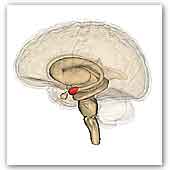News and Insights for
your best life. Online since 1998
- Home Health
- Breaking news
- In caso di...
- Per saperne di
più... - Medicina occidentale
- Medicine complementari
- Medicina cinese
e agopuntura - Omeopatia
- Fitoterapia

University of Texas Medical Branch at Galveston researchers have been awarded a five-year, $1.8 million grant by the National Institute of Neurological Disorders and Stroke to apply the techniques of gene therapy to the problem of neuropathic pain — that is, pain that arises from a malfunction in the nervous system.

Neuropathic pain is a daily reality for millions of Americans, manifesting itself in a variety of life-impairing ways. Someone suffering from neuropathic pain might feel intense discomfort in response to a light touch, for example, or suddenly feel as though he or she were freezing in response to a small decrease in temperature. Caused by either accidental or disease-induced nerve damage, this kind of pain has proven very difficult to treat.
“Patients in neuropathic pain are willing to do almost anything to get relief,” said Dr. Volker Neugebauer, the co-principal investigator on the grant. “They’re in torment, often in really desperate situations.”
To make matters worse, long-term neuropathic pain often causes depression, acting through emotional mechanisms in the brain meant to underscore the importance of pain signals. Depression further increases the perception of pain, creating a vicious cycle of increasing pain and depression. And while conventional pain medicines can block the pain signal, they are usually successful for only a limited time only; eventually the pain returns when the nervous system compensates for the blockade.
Neugebauer and his UTMB colleague and co-principal investigator Thomas Green believe that a better anti-neuropathic pain strategy is to target higher brain regions and prevent the abnormal generation of persistent emotions. They focus on the amygdala, a structure best known for its role in emotional responses, including anxiety and depression and — in Neugebauer’s previous work — for its connection to pain regulation. Neugebauer and Green hypothesize that stopping abnormal activity in the amygdala by a particular type of receptor for the neurotransmitter serotonin will enable the successful treatment of neuropathic pain.
Although increased serotonin activity in the brain is generally thought of as a good thing — it’s the mechanism used by many antidepressant drugs — activation of the serotonin 2C receptor in the amygdala can cause problems, according to Neugebauer. “In neuropathic pain we see that this receptor is activated on cells that regulate output from the amygdala to brain areas where responses to potentially harmful situations are generated,” Neugebauer said. “This activity should be turned off when such response is no longer needed or useful, but these serotonin 2C receptors continue to drive amygdala output, creating a chronic pain state.”
In experiments with laboratory rats in which neuropathic pain behavior has been induced by nerve damage, Neugebauer and Green plan to investigate the possibility of “re-normalizing” the amygdala by injecting it with specially designed viruses containing genetic material that blocks cells’ generation of serotonin 2C receptors.
“The viruses that we’re using are adeno-associated viruses, very common vectors that about 80 percent of the people in our society have been exposed to,” Green said. “We’ve modified them so that they can’t replicate, and inserted a gene that instructs the amygdala cells to make small pieces of RNA that interfere with the production of serotonin 2C receptors.”
According to Green, who has been working with similar gene-therapy techniques for more than 10 years, the viral injections produce permanent effects in the brain and no off-target effects. The researchers plan to test the rats’ response to the treatment with a variety of behavioral experiments that will examine both its effect on chronic pain behavior and behaviors associated with depression.
In addition to the behavioral investigation, the project will include electrophysiological studies of amygdala activity, in an effort to further define the “circuitry” of this key pain and emotion center. It will also examine the inconsistent results achieved when chronic pain is treated with selective serotonin reuptake inhibitor antidepressants, attempting to determine whether serotonin 2C receptor activity might be responsible.
“SSRIs increase serotonin, and most of the serotonin receptors produce good effects,” Neugebauer said. “But increasing serotonin also means you’re hitting the 2C receptor as well, perhaps mediating undesirable effects. We want to take that out and then see if increasing serotonin produces consistently good effects.”
For more information
The University of Texas Medical Branch
http://www.utmb.edu/
MDN
del Dott. Turetta
Quali sono i problemi o le disfunzioni che possono giovarsi di un intervento omeopatico d'urgenza e, di conseguenza, come dovrebbe essere un ideale armadietto medicinale omeopatico casalingo.- Home -
- Health -
- Depressione -
- Sexuality
- Environment -
- Food -
- Musica -
- Capirsi -
- Grafologia -
- Ridere
Copyright © 1998/2018 www.mybestlife.com tutti i diritti sono riservati eccetto quelli già di altri proprietari.
.In caso di
Pubblicità
Per saperne di più su
Pubblicità
Pubblicità
Pubblicità
Pubblicità


